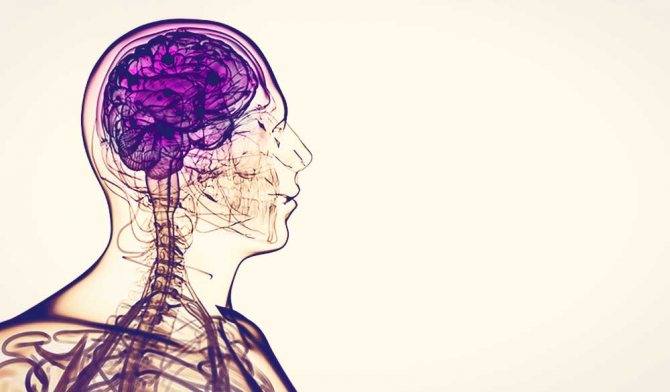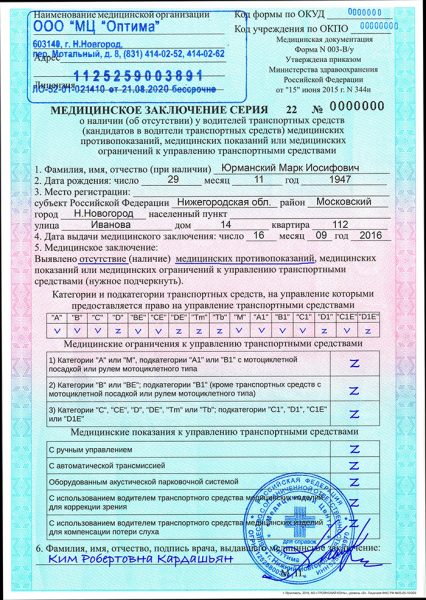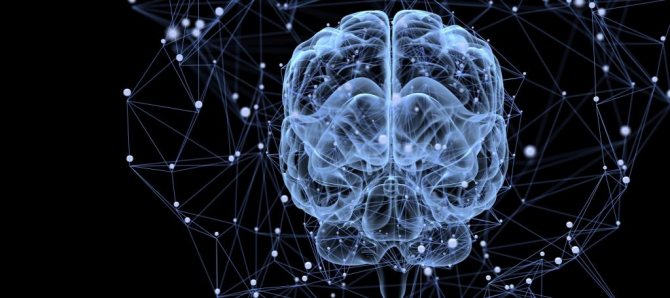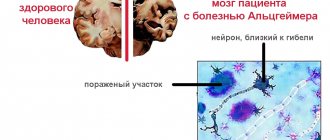What kind of disease is this
Epilepsy is a disease of a psychoneurological type.
A common symptom of epilepsy is sudden seizures that occur as a result of stimulation of one or more areas of the brain. During an epileptic seizure, a person cannot control his thoughts, feelings and movements. The vegetative functions of the body are also disrupted.
The causes of the disease may be:
- heredity;
- a consequence of injury or congenital abnormalities.
Experts also identify a third cause of epilepsy – cryptogenic, that is, it is not possible to detect the true nature of the disease. According to statistics, in 80% of cases it is not possible to determine the real cause of the disease.
After the first signs of the disease are detected, the person is under constant monitoring by a neurologist.
The patient is given a full examination to identify factors that have negatively affected their health, and specific treatment is prescribed.
Epilepsy is treated with medications that are aimed at:
- general anesthesia during an attack;
- reduction in seizure duration;
- reducing the number of attacks and increasing the interval between them.
In addition to drug treatment, surgical intervention is possible. The operation is justified if specialists manage to identify the causes of seizures as accurately as possible and find the source of seizure development.
Treatment with medications can be carried out both in a hospital and on an outpatient basis (the method is determined depending on the state of health). Some people have to take medications for the rest of their lives, while others only need one or two courses of treatment.
Relatives and friends should pay special attention to the patient, since during an attack a person cannot always cope with the situation on his own.
Often, due to improper first aid or simple ignorance from others, an epileptic attack ends in death. Quite often, a person’s death occurs if an epileptic attack occurs during sleep.
A patient with epilepsy should not be allowed to perform certain types of work, namely:
- work at height and underground;
- related to electricity;
- work on equipment under pressure;
- employees who are required to carry weapons;
- food industry;
- raising and teaching children;
- medicine;
- sport.
In Russia, persons suffering from epilepsy do not have the right to drive vehicles of any category. However, there are exceptions to all rules.
Design nuances
There are several subtleties associated with filing a case of epilepsy. How to remove the diagnosis is described in the official documentation, and it all begins with the gathering of a specialized commission, whose task is to examine the citizen. The chief physician of a particular medical institution may, for some reason, refuse to collect a commission. If the applicant does not agree with him, he has the right to go to court. In a particularly difficult situation, a period of hospitalization may be prescribed to continuously monitor the person’s condition.
Why patients should not drive a car
When driving a car, a person must be able to:
- make the right decisions instantly;
- control your body perfectly.
To reduce the number of road accidents, medical restrictions were introduced.
During an epileptic seizure in a person:
- brain function is disrupted. Some attacks are even accompanied by loss of consciousness;
- the functioning of the musculoskeletal system is disrupted. A person cannot independently control his arms, legs and other parts of the body. Spasms of various muscle groups often occur;
- mental disorders occur;
- Dizziness may occur. Some patients often experience hallucinations;
- the functioning of the organs of vision and hearing is impaired.
All these temporary disorders can lead to an emergency situation and death of surrounding people. Therefore, permission to drive for this category of citizens is limited.
The attending physician is obliged to report the detection of signs of epilepsy to the State Traffic Inspectorate for the purpose of temporarily restricting the right to drive.
Changes in driver's license exams in 2020 are described in the article: driver's license exam.
At what age do you get a driver's license in Russia? Read here.
Affects everyone
It is known that the color purple has a positive effect on the human nervous system, reducing anxiety, which is why it was decided to name the day of raising awareness of society purple. It was first proposed by a nine-year-old Scottish girl suffering from epilepsy. She was first supported by her compatriots, and then by the entire planet. The 26th day of March was chosen as purple; it is then that events are organized to demonstrate to society that there are no differences between healthy people and those who suffer from epilepsy. The purpose of these events is to prove the right of such people to live normally.
You should not assume that the problem of epilepsy can only worsen the lives of people with bad habits, chronic pathologies or any other disorders and problems. No one is immune, and an attack can happen at any age, in a representative of any gender and social circle. The initiator may be an injury received at birth, a concussion, an emotional experience, a tumor process, genetic characteristics and a toxic substance entering the body from the external environment. By the way, not so long ago the frequency of epileptic seizures increased in the industrial region of Bratsk.

Law restricting the right to drive
The medical commission makes decisions on the admission of people to certain jobs, including driving cars and other technical equipment, on the basis of Order No. 302n, adopted by the Ministry of Health on April 12, 2011. This document was last revised in December 2020
Diseases that limit the right to drive are covered in paragraph 27 with subparagraphs related to a specific category of vehicles.
In addition to epilepsy, restrictions for obtaining rights are:
- complete or partial loss of vision and/or hearing;
- other eye diseases;
- lack of full motor ability of the limbs;
- some diseases of the cardiovascular system;
- alcoholism and/or drug addiction;
- certain diseases of the human endocrine system;
- some gynecological diseases.
A complete list of existing restrictions for obtaining a driver’s license can be found by carefully studying the presented document.
Issues of provision
As stated above, today very often the diagnosis is made unjustifiably, and the person’s true problem lies in something else. For the same reason, the number of requests to reconsider a medical decision has increased. There are few specialists in epilepsy, since there is no such specialization in our country. Previously, all patients with epilepsy were observed by psychiatrists, which largely strengthened negative stereotypes of public opinion. Today this disease is considered a neuralgic pathology, but official restrictions create its own difficulties. A neurologist has the right to talk with a patient for only a quarter of an hour, and this time is not enough to determine the patient’s condition.
As experts point out, it is this format of work, coupled with the lack of specialization, that is the main reason for the high frequency of erroneous diagnosis. The manifestations of the disease are close to a number of other neurological disorders, and attacks most often affect young people. Epilepsy becomes a reason for prescribing treatment that is difficult for the body to tolerate, and this further worsens the situation. At the same time, many have been epileptics for many years, without suspecting this fact, since the attacks occur at night and are not accompanied by convulsions. There are patients who, in principle, do not have seizures; the disease manifests itself only by loss of consciousness.
In what cases are people with epilepsy allowed to drive a vehicle?
All drivers are divided into two large categories:
- persons driving vehicles not intended for transporting people. This includes categories A, B, C and their corresponding subcategories;
- persons involved in the transport of people (category D).
For the first group of drivers, the rules for admission to driving for medical contraindications are less strict than for the second group.
A person will be allowed to drive vehicles belonging to the first group if:
- he periodically undergoes medical examination until more than 5 years have passed since the last attack. A medical certificate for a driver's license must be issued once every 2 years. However, if you have epilepsy, the driver is required to undergo commissions at intervals specified by a specialist doctor;
- during examination by a neurologist, an individual conclusion was given about the driver’s fitness;
- more than 6 months have passed since the last attack, and during this period no symptoms of the disease appeared;
- according to experts, the patient does not have the possibility of an attack while driving, that is, driving a car is not a reason for a relapse of the disease;
- attacks of the disease occur exclusively during sleep;
- During an epileptic attack, a person’s consciousness and motor functions are not impaired;
- relapse of the disease is justified by discontinuation of the drug. The driver is suspended from driving for 3 months, provided that the course of medication is resumed;
- underwent treatment in the form of surgery.
You can drive vehicles of the second group if:
- More than 10 years have passed since the last attack, and during this time the person completely managed without medication;
- exclusively provoked attacks occur, and driving is not one of the irritants;
- There was a single attack that did not recur for 5 years.
Thus, it is possible to obtain the right to drive a vehicle for a patient with epilepsy. The decision is made by the attending physician (in some cases, a council of doctors) individually.
And it can be accepted with some restrictions, which are necessarily prescribed on the driver’s license.
To drive a car, you must have a medical certificate confirming the driver’s health status for a certain period of time.
Epilepsy is a contraindication for obtaining a driver's license. However, the decision is made by the medical commission in each individual case individually. The selected category of vehicle also influences the inspection result.
If you plan to drive a personal car, and without the need to work as a hired driver, then experts put forward more lenient health requirements than for other categories. Epilepsy can and should be treated.
The attitude of the people around the sick person is also important. Indifference can lead to the death of a person.
The punishment for repeated deprivation of a driver's license is discussed in the article: repeated deprivation of a driver's license.
Whether it is possible to change a driver's license before the expiration date is explained on the page.
Find out how to challenge the revocation of a driver's license for drunkenness from the information.
Since a long time
But the situation was not always this way. How to remove the diagnosis of epilepsy after treatment was indicated above: you need to go through a commission, having previously filled out an application for its organization. If doctors recognize a person as cured, he will no longer be “epileptic” in the eyes of society. But in ancient times everything was completely different. Previously, people considered epileptics to be messengers of the gods, but as Christianity spread, the sick were counted among those who were possessed by the devil. It is known that Socrates and Caesar had epilepsy, Nobel and Lenin were its victims, Dostoevsky and Flaubert had seizures.
Doctors of our time have more detailed information about the nature of the disease than centuries ago, but prejudices are still strong to this day. Parents, thinking about how to remove the diagnosis of epilepsy in a child, are not in vain putting in a lot of effort, organizing committees of doctors over and over again in the hope of a positive decision, because they know that their child with such a “label” in his personal medical record will be looked at as to an abnormal person. Every year the world holds a day to combat social prejudice in aspects of epilepsy, but this does not yet allow us to completely overcome the problem of poor awareness.
Other diseases that prevent you from becoming a driver
Decree No. 1604 also lists other diseases that may prevent a person from obtaining a driver's license. More precisely, it contains two lists:
- medical contraindications for driving a vehicle - a list of diseases for which it is prohibited to drive any vehicle;
- medical restrictions on driving a vehicle - a list of diseases for which you cannot drive a vehicle of a certain category; here are three lists for different categories: M, A, A1 (mopeds and motorcycles);
- B, BE (passenger cars with and without trailer);
- C, CE, D, DE, Tb, Tm (trucks, buses, trams, trolleybuses).
Epilepsy is a contraindication. In addition to this, this list includes:
- drug or alcohol abuse;
- dementia;
- schizophrenia;
- bipolar affective disorder;
- mental retardation;
- blindness in both eyes;
- achromatopsia.
You cannot drive mopeds and motorcycles if:
- the state of vision is as follows: one eye sees worse than - 0.6, and the other - worse than - 0.2;
- one eye is blind, the other sees worse than - 0.8;
The first five restrictions apply to categories B and BE. The list of rights restrictions for these categories also includes:
- absence of both hands;
- paralysis of both arms.
Problems with fingers or legs are not as important for car drivers as they are for motorcyclists.
The requirements for public transport and truck drivers are stricter because:
- For these people, driving a vehicle is a professional activity;
- greater responsibility (for passengers or transported goods).
You cannot drive a vehicle of categories C, D, Tm and Tb if:
- height below 150 cm;
- the best eye sees worse than - 0.8, and the other eye sees worse than - 0.4;
- a person is blind in one eye (and it doesn’t matter how the other eye sees);
- have chronic eye diseases;
- eye surgery was done less than a month ago;
- one arm or leg, hand or foot, fingers or phalanges are missing;
- the hand or foot is deformed;
- the leg is shortened by 6 cm or more;
- paralysis of arms or legs;
- there are diseases affecting the vestibular apparatus;
- there are injuries or deformations of the skull bones;
- have hearing problems.
What to expect?
If the treatment is chosen correctly, the patient strictly adheres to the rules established by the doctor, there is a high probability that the symptoms will soon go away and the attacks will not recur. After a stable state has been achieved, the doctor may decide to withdraw drug support. If a person’s condition remains stable without medications, after a few years (from three to two dozen) you can submit a petition to the clinic to collect a commission that will recognize the person as healthy.
Is it possible to get a license if you have epilepsy?
In the Russian Federation, as in many countries, obtaining a driver’s license takes place in two stages: passing an exam and issuing a medical certificate of suitability to drive a vehicle of a certain category.
It is realistic to undergo a medical examination only in accordance with Order No. 302n. it also spells out all types of diseases that make it impossible to obtain a driver’s license. Is epilepsy included in this list of diseases?
The normal functioning of the brain is disrupted.
About the advantages
It is possible to remove epilepsy diagnosed either correctly or incorrectly, even if it cannot be proven that the diagnosis was incorrect. This is due to the fact that the disease, previously considered a stigma for life, has now been transferred to the category of curable. The main task of the doctor in the case of correct identification of the disease is to choose the appropriate treatment format. Previously, the choice of medical products and procedures was extremely narrow, but today there are almost 500 types of medicinal compositions. Of course, this also creates difficulty, because choosing the optimal product is not easy, and choosing the appropriate volumes is no less difficult.

Conditions for obtaining a driver's license if you are color blind in 2020
When enrolling in courses at a driving school, you must provide a health certificate.
When undergoing a medical examination, special attention is paid to the condition of the future driver’s visual system and potential diseases, the presence of which will not pass the medical examination.
Let's look at what diseases do not give a driver's license and what vision restrictions for obtaining a driver's license apply today.
Removing the diagnosis of epilepsy (obtaining a driver's license)
Question: 1. Is it possible to remove a similar diagnosis mentioned above? 2.What is the procedure for making a diagnosis?
3. Is it possible to remove this diagnosis in a private clinic so that the PND accepts, say, the results of examinations of a private clinic??
4.Is it possible to obtain a driver's license? The question does not describe the “first attack.” What happened then? I know of cases where illiterate neurologists prescribed antiepileptic treatment to children with single attacks of febrile seizures (a variant of the norm.
)
What are the possibilities?
First, let's look at the general provisions that make up the process of how to remove a diagnosis. Epilepsy is a serious disease, and its absence can only be confirmed if, when initially diagnosing, doctors indicated a number of key characteristics of the patient’s illness. It is possible to remove an entry from a patient’s medical record only in certain forms of the disease. So, if rolandic epilepsy is diagnosed, the person has completed a full course of treatment, after which remission has continued for several years, we can talk about a cure. In such a situation, the diagnosis is removed.
What medical restrictions are established for obtaining a driver's license?
Federal Law of December 10, 1995 No. 196 “On Road Safety” (hereinafter referred to as Federal Law-196) established the need to conduct medical examinations, examinations and regular checks of all those who are going to become participants in this very traffic. Of course, each category of driver has its own deadlines and rules.
For example, public transport drivers are required to undergo a medical examination before each shift.
Receipt, replacement and restoration of rights are carried out only with a medical certificate of form 083/у-89. The certificate is issued after passing a medical examination at a licensed medical institution.
Restrictions for health reasons are listed in Order of the Ministry of Health and Social Development of the Russian Federation No. 302n dated April 12, 2011.
Color blindness in most cases will no longer be an obstacle to obtaining a driver's license - impaired color vision is excluded from the contraindications.
Epilepsy and driving
As you know, vehicles (hereinafter referred to as vehicles) are sources of increased danger, therefore strict requirements are imposed on future drivers, including health requirements. The Decree of the Government of the Russian Federation dated December 29, 2014 No. 1604 (hereinafter referred to as Decree No. 1604) contains a list of diseases that “prevent the ability to drive a vehicle.” These include, in particular, epilepsy. Epileptics will not be given mandatory medical treatment. conclusion required to obtain a driver's license. That is, people with epilepsy cannot obtain a driver’s license, since this is expressly prohibited by law.
It is simply dangerous for an epileptic to drive. This situation is explained by the properties of the disease:
- epileptic seizures are sudden and uncontrollable;
- External stimuli can trigger an attack: light, sound, environment.
The first point applies to all people with epilepsy. Any attack begins and ends suddenly. An epileptic cannot influence it in any way: prevent or stop it. And it is quite possible that the attack will begin while driving. This is dangerous both for the driver himself and for those around him. Especially if the attack manifests itself in the “classic” form, when a person not only cannot drive a car, but is not able to control his muscles.
The second point does not always work, because external stimuli provoke attacks only in the reflex form of epilepsy. If a person suffers from just such epilepsy, then it is unsafe for him to be a driver. After all, there are enough external stimuli on the road: headlights from the oncoming lane, the roar of trucks, dangerous situations that cause stress (for example, a pedestrian suddenly ran out onto the road or some bad driver broke the rules and cut off). All this sometimes tires even experienced drivers in good health, but it can have a more serious impact on a person with epilepsy.

A medical certificate for obtaining a driver's license is not issued to people suffering from epilepsy.
Relevance of the issue
It so happens that there are many patients with this disease in our country, so everyone has heard about epilepsy. Not everyone in Russia knows how to remove a diagnosis, and not everyone thinks about it. But people who are forced to live with this disease often want to know how to do this. Indeed, such an entry in the medical record imposes strict restrictions on social activity. A person who has received a “sentence” cannot serve in the army; he is prohibited from driving vehicles or engaging in a number of other forms of activity.
Many people do not understand why they need to know how to legally remove a diagnosis. Epilepsy seems to most of our compatriots a convenient way to “evade” the army, but not every person thinks about the long-term consequences. It is known that every year the commission erroneously assigns this diagnosis to many malingerers. It is they, years later, who begin to look more actively than others for how to get rid of the entry in the medical record, which has such a catastrophic effect on life.










